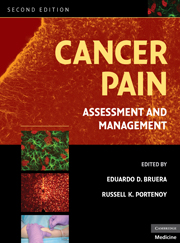Book contents
- Frontmatter
- Contents
- Contributors
- Preface
- SECTION I MECHANISMS AND EPIDEMIOLOGY
- SECTION II EPIDEMIOLOGY AND SYNDROMES
- SECTION III ASSESSMENT
- SECTION IV PHARMACOLOGICAL TREATMENT
- SECTION V OTHER INTERVENTIONAL STRATEGIES
- 16 Neural blockade for cancer pain
- 17 Neurosurgical treatment of cancer pain
- SECTION VI REHABILITATION AND PSYCHOLOGICAL INTERVENTIONS
- SECTION VII THE ROLE OF ANTINEOPLASTIC THERAPIES IN PAIN CONTROL
- SECTION VIII PAIN IN SPECIAL POPULATIONS
- SECTION IX DIFFICULT PAIN PROBLEMS
- SECTION X SYSTEMS OF CARE
- Index
- Plate section
- References
17 - Neurosurgical treatment of cancer pain
from SECTION V - OTHER INTERVENTIONAL STRATEGIES
Published online by Cambridge University Press: 06 July 2010
- Frontmatter
- Contents
- Contributors
- Preface
- SECTION I MECHANISMS AND EPIDEMIOLOGY
- SECTION II EPIDEMIOLOGY AND SYNDROMES
- SECTION III ASSESSMENT
- SECTION IV PHARMACOLOGICAL TREATMENT
- SECTION V OTHER INTERVENTIONAL STRATEGIES
- 16 Neural blockade for cancer pain
- 17 Neurosurgical treatment of cancer pain
- SECTION VI REHABILITATION AND PSYCHOLOGICAL INTERVENTIONS
- SECTION VII THE ROLE OF ANTINEOPLASTIC THERAPIES IN PAIN CONTROL
- SECTION VIII PAIN IN SPECIAL POPULATIONS
- SECTION IX DIFFICULT PAIN PROBLEMS
- SECTION X SYSTEMS OF CARE
- Index
- Plate section
- References
Summary
Over the past 30 years, there have been significant changes in neurosurgical approaches to the treatment of cancer pain. Specifically, there has been a substantial decrease in the number of ablative procedures and an increase in the number of interventional pain and implantation procedures for treatment of chronic pain. The application of ablative surgery has been diminished in part because of the increasing recognition that some types of persistent pain are the result of injuries to the nervous system. In the treatment of pain of malignant origin in patients with a life expectancy of less than 3 months, this is often less of a concern, as the pain relief provided by the procedure is often good for the patient's remaining life.
The indications for all pain treatment, particularly neurosurgical treatments, are dependent on the type of pain. Nociceptive pain refers to pain arising from the activation of peripheral nociceptors and transmitted to the central nervous system through intact somatic sensory pathways. Examples of nociceptive pain include acute cancer pain secondary to invasion of bone. This pain has been said to respond well to opiates. Neuropathic pain refers to pain arising from injury to the nervous system either peripherally, such as malignant invasion of pancreatic cancer into the celiac plexus or diabetic peripheral neuropathy, or centrally, such as post-stroke pain. It has been suggested that central pain does not respond to opiates, although this is certainly not universally accepted.
- Type
- Chapter
- Information
- Cancer PainAssessment and Management, pp. 329 - 340Publisher: Cambridge University PressPrint publication year: 2009



